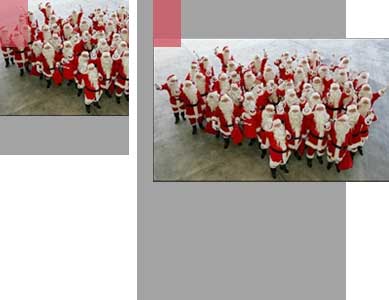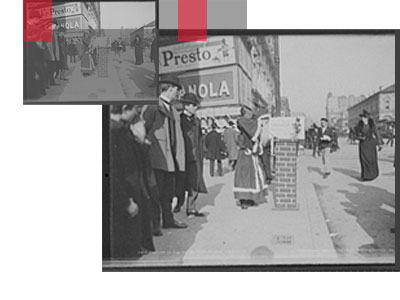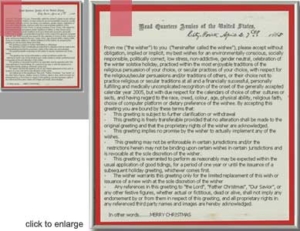Santa Timeline
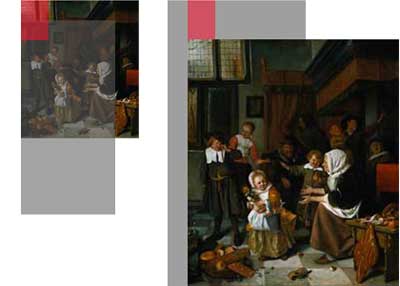
“This time line is a document authorities discovered in B’s journal that is believed researched and compiled by B and is presented to the public as further evidence of her action”.
In looking for the seeds of what we have come to know as Santa Claus i have traced it back to one person but, he is mostly a northern hemisphere phenomenon-mixed effort-of myths, creatures and legends…Santa is your basic mutt. However, my search has led me to conclude that the connection between today’s Santa Claus & Christmas is a contrived invention by a handful of “respectable” men living in New York City circa the 1820’s.
This time line document in no way reflects or represents any policy or position of any individual or organization in any way connected to the project.
280 AD
Hagios Nikolaos of Smyrna, aka: Myra, was born in (presently Turkey) to wealthy parents. When the plague killed his parents little Hagios was orphaned to a monastery and by the early age of 17 he became a priest. Smyrna was a fishing village located in southwest Turkey. Because many fishermen lost their lives at sea Kikoloas extended great care and kindness to those children and families who where now fatherless.
Becoming famous for his kindness and generosity toward all, especially the children by ( legend ) Nikolaos dropped bags of gold down chimneys which sometimes landed in stockings hung to dry by the fireplace and for tossing bags of gifts through open windows of the cottages. One legend has Nikolaos restoring to life three boys murdered, chopped up and pickled in a vat of brine by a butcher to hide the crime, thereby becoming the patron saint of schoolboys.
Another has Nikolaos giving three bags of gold to daughters of a poor man thus saving those girls from a life of prostitution. This story evolved into three gold balls which became the symbol for pawnbrokers. Some legendary versions have Nikolaos born in the city of Patara then traveling to Egypt and the Holy Land where he was jailed by Roman Emperor Diocletian during his persecution of the Church and later released by the new more liberal Emperor Constantine. Either way, Nikolaos was elevated to the position of Archbishop. He is described as wearing a tall Bishop’s hat, flowing white gown, a red Bishop’s cape and holding a Bishop’s staff. It was also reported that he had a long white beard
.
345 or 352 AD
December 6, Bishop Nikolaos dies and due to his good works and no less than 21 “miracles” credited to him he is eventually elevated to Saint.
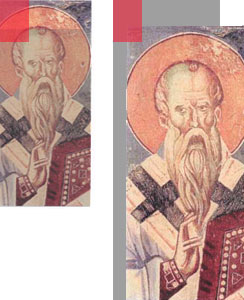
400 AD
About this time the Church picks December 25th as the date to observe Christmas because this was a period more closely associated with the long time celebrated winter solstice than with any religious theme. The Romans celebrated Saturnalia, named after their god of the harvest: Saturn, about December 17 and extended for several days after. During this celebration schools and the courts were closed, gifts were exchanged, war was outlawed and masters and slaves shared the same table. Not an altogether bad idea for a bunch of pagans.
540 AD
Basilica was erected over the tomb of and dedicated to Saint Nikolaos.
600 AD
In England, occupied by the Saxons who honor King Winter – or King Frost – or Lord Snow by inviting a “character” dressed in a fur hat or a crown into their homes for a friendly fireside chat, which insured a mild winter.
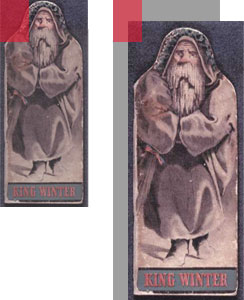
800 -900 AD
In England, now occupied by Vikings who are ruled by their chief God Odin, who comes as twelve assorted characters, one for each month. The December character was called Yalka or Jule and December, was called Jultide or Yuletide. Jultid was the month of Odin’s earthly visit. On this visit Odin disguised himself with a long hooded blue robe and carried a satchel full of bread. He also was old, had a long grey beard and a big hat pulled down to cover a bad eye. He would visit families, sitting by the fire with them, listening to their stories of the past year. He would determine from those stories who had faired well and would leave bread from his satchel for those whom he determined were suffering.
Thor, a germanic god, was god of thunder. He was short tempered, a little stupid but really good hearted and came for visits riding a chariot pulled by two goats named Gap-Tooth and Tooth Grinder.
842 AD
The first story about Saint Nikolaos appears in print. A certain best seller.
987 AD
Saint Nikolaos becomes the patron Saint of Russia.
1000 AD
By now rituals and practices of Paganism and Spiritualism have experienced a merging throughout most of Europe and the beginnings of a completely “contrived” holiday celebration-observance known as Christmas. Pagan rituals of the winter solstice, the shortest daylight of the year, used candles and greenery, holly, the yule log, mistletoe and even the Christmas tree to celebrate the return of longer daylight. This was also behind the idea of Chanukah or “feast of lights”. None of these rituals had any relation to the birth of Jesus.
1087 AD
The relics of Saint Nikolaos are stolen from Myra ( Turkey ) and are placed in the Basilica of St. Nicola, in Bari, Italy. So, because of this
theft he is known in places as Saint Nikolaos of Bari.
1200 AD
The Saint Nikolaos legend spreads and pilgrimages are made to a church built in his honor by Emperor Justinian I in Constantinople. In central Europe December 6 becomes St. Nikolaos Day, a celebrated feast day where gifts are given to poor children in his honor. The first musical play about Saint Nikolaos is published.
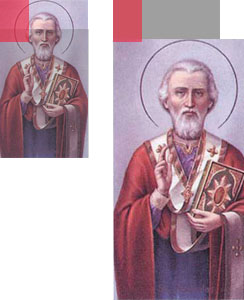 1300 AD
1300 AD
The first depiction of St. Nikoloas with a long white beard and a herder of reindeer due to his acceptance in “Lapland”.
1400 AD
Up to now several thousand churches and chapels and hundreds of songs are written in honor of Saint Nikolaos. He has become the patron saint of children, sailors, prisoners, pawnbrokers, Sicily, Greece and several other countries, cities and villages and the patron saint of wolves.
1492 AD
Chris Columbus wades ashore on December 6 on what is now Haiti and names the port St Nicholas.
1500 AD
For centuries now, the Christmas holiday “season” or Winter Solstice is a time of excessive drinking, feasting, rude and offensive public behavior including but not limited to mocking of authority, aggressive begging, public fornication, home invasion of the rich ( this is linked to the idea or custom of “trick or treat” whereby the lowly could “knock” and ask for a drink or to be seated at the notable’s table for “treat” and if denied a a nasty “trick” would be made against the house. ) This accepted behavior was called “Misrule”. Another act of “misrule” would be to black one’s face and cross-dress ( called Mumming ) or make disguise as animals to provide anonymity for debauched public behavior which included the disgraceful act of “Christmas caroling” ( drunken sing-a- longs ) At the time Misrule had little or no major threat upon society, it really strengthened the status quo by allowing the less fortunate, the poor and powerless, an opportunity to blow off steam. Sounds a lot like our modern “spring break”.
The Winter Solstice celebration or feast came in December because it was the end of the harvest with less daylight and to cold to plow, but cold enough that slaughtered animals could be eaten and stored and the beer and wine was ready to drink.
1517 AD
Martin Luther posts his 95 theses on the front door of the Castle Church, signaling the beginning of the Protestant Reformation.
Well, those Protestants decided to put sizable distance between themselves and the gift giving Patron Saint Nicholas of the Catholic Church and set about to create their own gift giving characters. In Germany he became Christmas Man ( Weihnachtsmann ) or Kris Kringle from the German term for “the Christ Child” also Belsnickle a term derived from Pelz-nickle meaning “St Nicholas in fur” and that was probably based on an earlier character known as Knecht Ruprecht ( Rupert the Servant ) dressed in “high buskins, a white robe, a mask, and an enormous flax wig”.
In the Netherlands he was known as Kerstman and later Sinterklaas and rides a white horse and leaves gifts in wooden shoes. Sinterklaas was mispronounced ( of course ) by those New, New Yorkers to become Santa Claus. The French called him Pere Noel. In Norway he was Pa Norsk and in Sweden it’s Jultomten and arrives the day before Christmas pulling a big bag of julklapper (Christmas presents). In Russia he was Ded Moroz and even the commies called him Grandfather Frost who was dressed in blue rather than red. i would have guessed red would have been completely appropriate.
Editors note: Not to ignore, or exclude other parts of the worldly neighborhood, the gift giver is known in Spain as Papa Noel, in Italy as Babbo Natale ( Father Christmas), In Japan he is Santa Clause or sometimes Santa no ojisan ( which means uncle santa ), in Findland he is Joulupukki, in most all of Latin America, Costa Rico, Columbia and Mexico, el Nino Jesus ( the infant Jesus ) who brings the gifts to children and in Morocco he is good old Black Peter.
1587 AD
Christmas as it was practiced for several centuries was temporarily “outlawed” in the American Colonies. Nice move by the fun loving Puritans.
1600’s
In most all European counties Saint Nicholas Day, December 6th is a feast day to celebrate “the entry of the saint’s soul into heaven”. The Saint usually arrives the night before accompanied by an ugly, chain-rattling little devil, “Krampus” who is the one to deal with the naughty children because Saint Nicholas is much to kind to do any punishing.
1626 AD
A ship with a figurehead of Saint Nicholas sails for the new world with Dutch settlers. They land and name the new settlement New Amsterdam know known as New York City and Nicholas became the Patron Saint
1644 AD
British Puritan Parliament decreed December 25 to be a day of fasting and repentance to renounce the “traditional” Christmas celebration.
1650’s AD
Riots in many towns and villages to protest the banning of the traditional Christmas celebration.
1660 AD
British Monarchy reverses Parliaments decree and restores Christmas.
1659 -1681 AD
Massachusetts Bay Colony passes a law making it illegal to celebrate Christmas. Five shillings was the fine for anyone “found observing any such day as Christmas”.
1662 AD
” The Day of Doom” A little poem written and published by Michael Wigglesworth, a Massachusetts clergyman, depicting the church approved frightening judgment day, not the “nice” judgment day of St. Nicholas day celebration of December 6. This poem was very popular in its own time up to the early 1800’s.
1663-1665 AD
“Hes feest van Saint Nicholaas” by the Dutch painter Jan Steen. The painting depicts St Nickolas day as a kind of judgment day with both gifts and punishments which was associated with the day
in most of north central Europe and apparently St Nicholas was the judge. This links to the idea of “you’d better watch out…Santa Claus is coming to town”… “he knows if you’ve been bad or good” ” so be good, etc”. The good got a cookie, the bad got hit with a stick.

1668 AD
The Christmas demon Knecht Rupprecht first appeared in a play in 1668 and was condemned by the Roman Catholic as being a devil in 1680. . . To the Pennsylvania Dutch, he is known as Belsnickel. Other names for the same character are Pelznickle, “Furry Nicholas,” and Ru-Klas, “Rough Nicholas.” From these names, it is easy to see that he is looked upon as not merely a companion to St. Nicholas, but almost another version of him. (Del Re, Gerard and Patricia. The Christmas Almanack. New York: Random House, 2004, pp. 93,94)
1686 AD
A British book “The Tryal of Father Christmas” was published mocking the Puritans who suppressed Christmas. An early Murdock publication, no doubt.
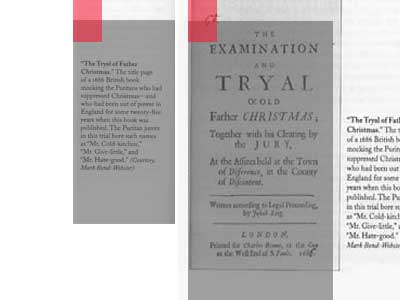
1690 – 1700 AD
Due to the fun of Christmas’s past it began to show signs of a come back in the American Colonies. It was hard to keep a good cross dresser out of the village square.
1731 AD
First published notice of the German tradition of candles on a “Christmas Tree”.
1773 AD
St Nicholas makes news in the New York Gazette as “St. A. Claus”
1776 AD
The first American Christmas Tree.
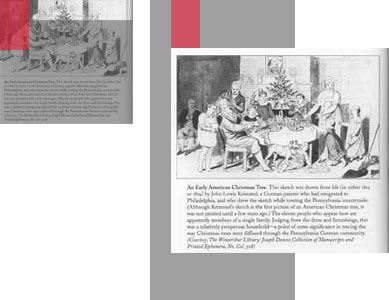
1809 AD
Washington Irving credited with inventing Santa Claus in a collection of stories published in “Knickerbocker’s History of New York”. He mentions St Nicholas 25 times and described him as “a genial yet obviously patrician saint dressed in a broad hat and invariably smoking a long pipe” and arrived each Eve of St. Nicholas driving a wagon. Irving also invented the phrase “laying his finger beside his nose”. The book was published on St. Nicholas Day, December 6, 1809.

1810 AD
St. Nicholas is introduced to and celebrated by the New York Historical Society by John Pintard, but not for any association with Christmas but as the mostly forgotten mythic patron saint of New Amsterdam.
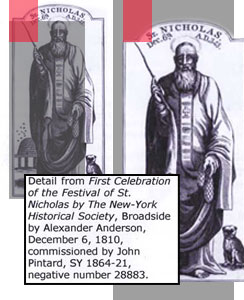
1816 AD
The Nutcracker and the Mouse King , a long short story by E.T. A. Hoffmann & the song Silent Night are written.
1820 AD
By this time Christmas misrule becomes a serious social & financial threat to respectable New York. Gangs roamed the streets “mummied” up terrorizing the wealthy neighborhoods and displaying horrid acts of drunkenness and rage. John Pintard, a prominent New York City merchant and civic leader, a firm believer in ceremonies and rituals and a major force in establishing Washington’s birthday, Columbus Day and the Fourth of July as national holidays had been working for nearly 20 years to nullify the Christmas holiday scare the lower classes were putting upon the upper class. No Christmas rituals existed that were acceptable to the upper class so Pintard worked to self-consciously invent a tradition.
1821 AD
“Santeclaus” a poem printed by a New York printer Wm Gilley, has santa dressed all in fur and drove a sleigh pulled by a reindeer.
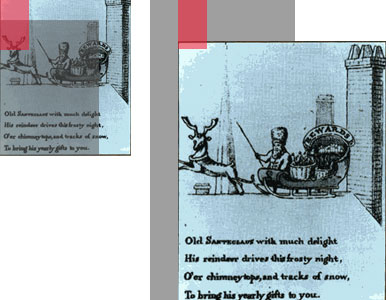
1822 AD
Clement C. Moore writes “A Visit from St. Nicholas” better known as “The Night Before Christmas”. This bares a slight resemblance to the 1662 ditty of doom by Wigglesworth however, “A Visit” was for fun and about dreaming of all the good things, not eternal damnation.
So, this happy little poem Mr Moore wrote for his darling daughter makes a major contribution to the invention of a socially acceptable contrived Santa Claus embedded Christmas.
Mr Moore was a frightened major Manhattan land owner who successfully protected his holdings from the encroaching lower classes by reforming the city landscape through clever real estate deals.
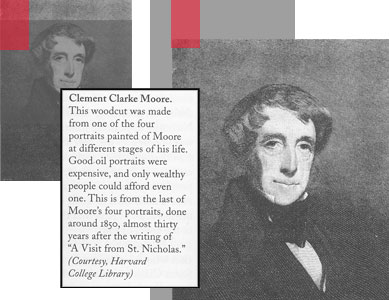
1823 AD
“A Visit from St. Nicholas” is first published in the Troy Sentinel,Troy, New York.
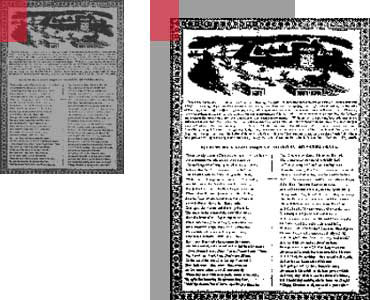
1824 AD
Mr Moore’s poem published in at least four different Philadelphia almanacs.
1825 ish AD
The first usage of Santa Claus as an enticement to sell goods. It was a published verse by a New York jewelry shop to sell “The choices gems to buy…”
1828 AD
The popular Poulson’s Daily Advertiser printed “A Visit from St. Nicholas”.
1829 AD
A New York paper and latter Poulson’s reprinted the same article detailing the Santa Claus ritual.
1830-31 AD
A National Gazette editorial explains the “inner meaning” of the new Christmas. The popularity of “A Visit form St. Nikolas” assisted Pintard in turning the scary outside Misrule “for all” debauch into an inside “invitation only” celebration with the children of a household replacing the larger group of the poor and powerless.
With the attempt to promote December 6th long forgotten Pintard proclaimed the new rituals of Christmas were “ancient usage” and that “St Claas is too firmly riveted on this city ever to be forgotten”
1836 AD
Alabama is the first state to declare Christmas December 25th. The first published Christmas tree.

1840 AD
Christmas traditions by Isis Quan: A look at two early representations of Santa Claus in the United States, both dating from the late 1840s. The first is said to have been the earliest published image of old St. Nick, appearing in an 1847 edition of an 1845 children’s story by Benjamin M. Dusenbury (who went uncredited) called Kriss Kringle’s Christmas Tree: A Holiday Present for Boys and Girls, issued originally by E. Perrett and Company, with the second edition by the firm of Grigg & Elliot, both of Philadelphia. Note the use of the name “Kriss Kringle,” which has hardly been used in recent years, except for those of us “of a certain age” who recall the Mickey Rooney-voiced Kris Kringle in the 1970 Rankin and Bass stop-motion animated television special, Santa Claus is Comin’ to Town.
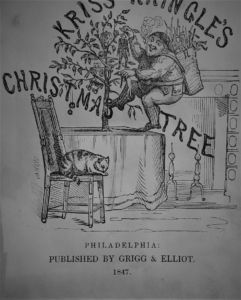
Reputed to be the first published image in America of Santa Claus, here is “Kriss Kringle” in an 1847 edition of an 1845 story for children called Kriss Kringle’s Christmas Tree, an original copy of which is in the museum’s collection.
As a sidenote, this 1847 edition has a few words to say about changing Christmas traditions, specifically the replacement of hanging stockings on the fireplace mantel in favor of a table-top tree “to await the annual visit of the worthy Santa Klaus.” In fact, the book went on, Santa “has, with his usual good nature, accommodated himself to this change in the popular taste” by having the book written. Therefore, the quote concluded, all adults who were “desirous to conform to the most approved fashion” were recommended “to hang one, two or a dozen copies of the book on their Christmas Tree for 1847.”
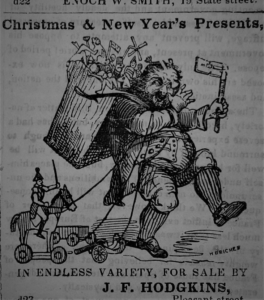
As to the appearance of “Kriss Kringle”, a.k.a. “Santa Klaus,” note that he was a short stout figure, with what appeared to be a woven basket on his back held by straps wrapping around the front. While he looked ready to tumble backwards off the table with one foot in the air, he somehow remained balanced enough to have presents in both hands ready to hang on the rather sparse-looking tree (though still lush compared to poor Charlie Brown’s tree some 120 years later!) The cat on the tall-back sidechair could hardly be more impressed or concerned with the proceedings, though.
Compare this rendition of Santa with one two years later in a drawing by “H Briche[s]” in an advertisement for a merchant in the Newburyport (Massachusetts) Herald of 3 January 1849. The ad did first appear a few days before Christmas, however. The merchant, J.F. Hodgkins of the nicely named Pleasant Street, didn’t have much to say (or enough money to say more, probably) in his ad, noting that he offered “Christmas & New Year’s Presents, in Endless Variety, For Sale.”
1841 AD
A Philadelphia merchant, hired a man to dress in “Criscringle” attire and climb the chimney outside his shop to attract customers. Another version has the same merchant using a life size model that managed to “attract thousands of children to his shop”.
The local paper reported ” no lad who see it, will ever after accuse pa or ma of being the Kriss-Kringle who filled his stocking. That such a person exists will be most indelibly fixed upon their memory”
From the start, it has been difficult to convince ( flat out lie ) to children that Santa brings the gifts when in fact the gifts are from family.
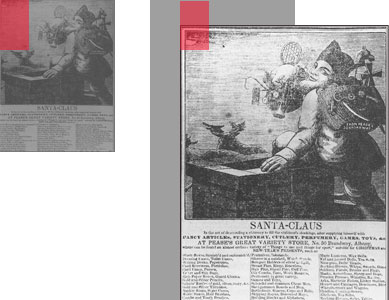
1842 AD
The first commercial publication of the image of Santa Claus for an advertisement for Pease’s Great Variety Store, Albany, NY.
1843 AD
Charles Dickens writes “A Christmas Carol”.
First Christmas Cards.

1845 AD
“original advertisement appeared in the New York Journal or General Advertiser, 1768″
According to Narrative of the Life of Frederick Douglas written by Himself circa 1845, ” It was deemed a disgrace not to get drunk at Christmas; and he [ a slave ] was regarded as lazy indeed, who had not provided himself with the necessary means, during the year, to get whisky enough to last him through Christmas …These holidays serve as conductors, or safety-valves, to carry off the rebellious spirit of enslaved humanity…the slaveholders not only like to see the slave drink of his own accord, but will adopt various plans to make him drunk… …the holidays are part and parcel of the gross fraud… So, when the holidays ended, we staggered up from the filth of our wallowing, took a long breath, and marched to the field, – feeling, upon the whole, rather glad to go, from what our master had deceived us into a belief was freedom, back to the arms of slavery…
“When I read this, it changed my life. What was written in 1845 seemed so familiar and I couldn’t help but notice things haven’t changed.”
Note written by B
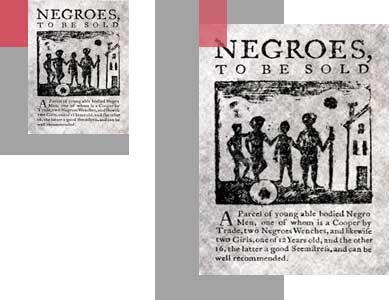
1848 AD
The first long version of “Visit From Saint Nicholas” published.
1860 AD
The parlor song “Jolly Old St. Nicholas” is the first Christmas song.
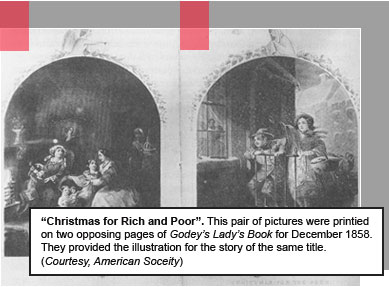
1863 AD
At the request of President Lincoln, Thomas Nast, the political cartoonist, made a picture depicting Santa Claus with the Union troops appearing on the January 3, 1863 Harpers Weekly Cover. This and other drawings by Nast had a crushing effect on the South. Souther parents had to tell their children there would be no gifts at Christmas because even Santa could not get through the North blockaded Southern ports. This Nast Cover was the first of over 150 Santa illustrations Nast would make and it marked the beginning of the modern standard version of Santa Claus.
This makes a point that Santa Claus was a Social, Economic and Political tool.
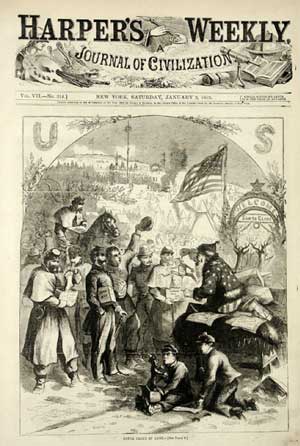
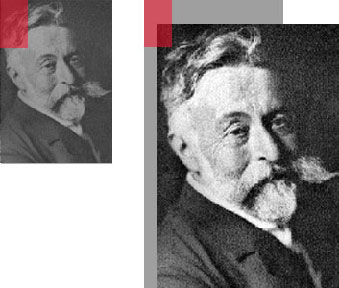
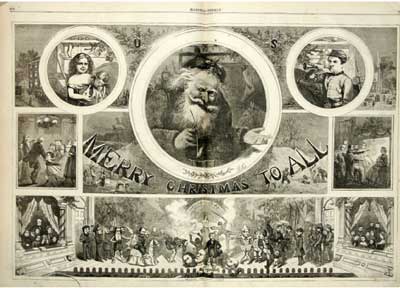
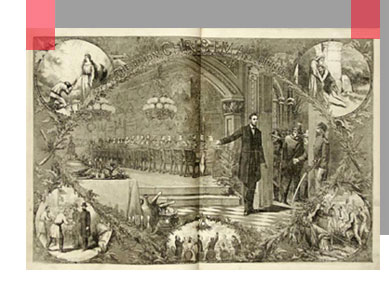
1870 AD
Santa Claus appears in US and Canadian department stores.
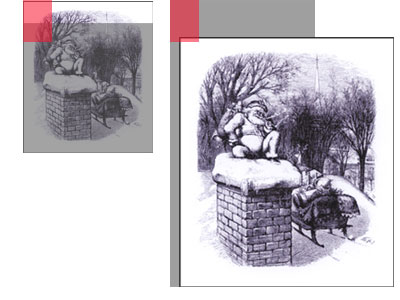
1892 AD
The Nutcracker Ballet is performed in the Miriinsky Theatre, in Russia.
1897 AD
The New York Sun prints an Editorial “Yes, Virginia, There is a Santa Claus” in response to a letter by the little girl who noted that her “little friends” told her there was no Santa Claus. Like dah!
1902-03 AD
Frank Baum, author of “The Wizard of Oz” publishes “The Life of Santa Claus”.


The Life & Adventures of Santa Clause by Frank Baum
1920 AD
Norman Rockwell creates a Santa Claus for Saturday Evening Post Cover.

Norman Rockwell Gallery – Click to Enlarge
1924 AD
November 27th, The first Macy’s Thanksgiving Day Parade.
1931 AD
Coca-Cola hires Haddon Sundblom to create the modern Santa we know today and Coca-Cola introduces the NEW Santa at the 1931 Macy’s Thanksgiving Day Parade. Sundblom Santa’s would appear in advertisements for Coca-Cola and the back covers of the Saturday Evening Post and National Geographic until 1964.
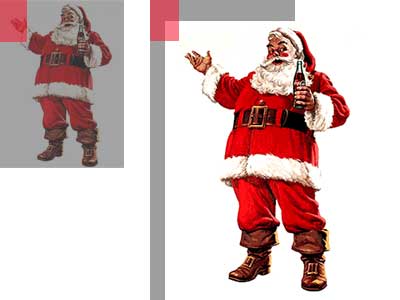
One may surmise that the accepted “traditional” Santa Claus and Christmas celebration is a completely contrived invention of several prominent individuals of New York City.
In short: New York City invented Santa Claus and Christmas.
Christmas merchandising show signs of a snow flurry.

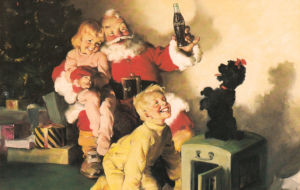
1934 AD
The Christmas Madness begins and Eddie Cantor records “Santa Claus is Coming”
1935 AD
“Santa Claus Express” another Eddie Cantor record.
“What Would Santa Say” a record by Louis Prima begins the idea of pushing what present to buy.
“Scrooge” the movie, based on Dicken’s “A Christmas Carol”, is released.
1939 AD
Christmas Merchandising begins to snowball.
“Rudolph the Red Nosed Reindeer” was invented by Robert L. May an advertising writer for Montgomery Ward.

1941 ish AD
Fred Waring’s “Night Before Christmas” is a gold record
1942 AD
The movie “Holiday Inn” is released
1946 AD
The movie “It’s a Wonderful Life” is released. Not a big hit at the time but eventually becomes an American Classic due to repeated TV and cable broadcasts.
1947 ish AD
The movie “Miracle on 34th Street” is a big hit. The “real” Kris Kringle is hired to play Santa Claus in the Macy’s Thanksgiving Parade and goes to great lengths to prove himself to the cynics.
Bing Crosby’s “White Christmas” from the movie Holiyday Inn grows in popularity employing the contrived idea of nostalgia to Christmas music.
Nat King Cole records “Chestnuts Roasting…” the first version did not sell. Record pulled out of the stores. Within two weeks strings are added and re-released and it becomes a huge hit.
1949 AD
“Rudolph the Red Nosed Reindeer” record by Gene Autry, sells 2 million copies.
1950 AD
“Santa Claus Got Stuck in My Chimney” record by Ella Fitzgerald. Santa begins to show signs of sexuality.
1951 AD
“I Saw Mammy Kissing Santa Claus” by Jimmy Boyd. More sexuality.
1953 AD
“Santa Baby” by Ertha Kitt. Santa is real sexy.
1954 AD
The song “White Christmas” from the movie “Holiday Inn” becomes such a huge hit that the movie is re-made and released as “White Christmas”
1956 AD
“Up On the Rooftop” by Gene Autrey from an 1866 parlor song “Old Santa Claus”.
1957 AD
The children’s book “How the Grinch Stole Christmas” by Dr. Seuss is published
1958 AD
Lawrence Ferlinghetti, famous for running the City Lights bookstore in San Francisco, wrote this poem in the 1950s and published it in his book: A Coney Island of the Mind, Poems by Lawrence Ferlinghetti, A New Directions Book, Copyright 1958 by Lawrence Ferlinghetti.
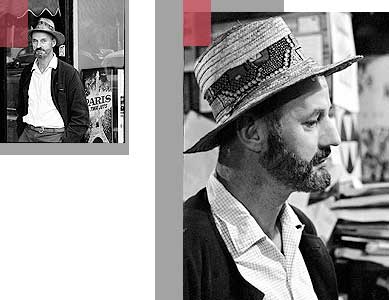 |
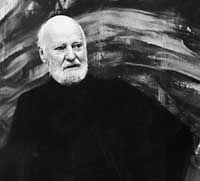 |
| Click to Hear & Read the Poem: Christ Climbed Down www.citylights.com |
|
1962 AD
“Mr Magoo’s Christmas”
The Christmas Merchandising Machine develops into a blizzard.
1964 AD
Phil Spector records of “Santa Claus is Coming to Town”
TV movie “Rudolph the Red Nosed Reindeer” airs.
The movie “Santa Claus Conquers the Martians” is released. Santa is kidnapped by martians because martian kids are jealous.


1966 AD
“Surfin’ Santa” by the Beach Boys
“How the Grinch Stole Christmas” a made for TV cartoon by Chuck Jones and the Dr, Seuss song “You’re a Mean One Mr Grinch” by Thurl Ravenscroft ( the voice of Tony the Tiger ) becomes a hit.
1968 AD
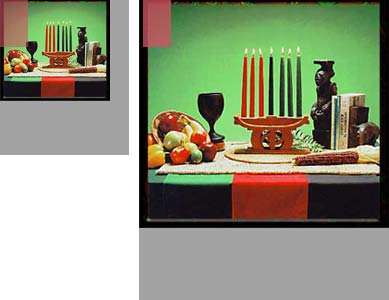
Kwanzaa is created by Dr. Maulana Karenga
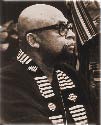
Kwanzaa A Celebration of Family, Community & Culture
The Symbols of Kwanzaa
- Mazao (The Crops) These are symbolic of African harvest celebrations and of the reward of productive and collective labour.
- Mkeka (The Mat) This is symbolic of our tradition and history and therefore the foundation on which we build.
- Kinara (The Candle Holder) This is symbolic of our roots, our parent people – continental Africans.
- Muhindi (The Corn) This is symbolic of our children and our future which they embody.
- Mishumaa Saba (The Seven Candles) These are symbolic of the Nguzo Saba, the seven principles which African people are urged to live by in order to rescue and reconstruct their lives in their own image and according to their own needs.
- Zawadi (The Gifts) These are symbolic of the labour and love of parents and the commitments made and kept by children.
Reference: www.officialkwanzaawebsite.org
1969 AD
Pope Paul VI removes Saint Nicholas and 92 other saints from the calendar of saints changing the December 6th feast day from obligatory
to voluntary veneration.
1970 AD
AD The movie “Scrooge” is re-made a musical.
1984 AD
“Silent Night, Deadly Night” is released. “Santa” hacks away at naughty teens.

1986 AD
“Silent Night, Deadly Night II” recycled footage from the first movie.
1988 AD
Yet another movie called “Scrooged” is released on the public.
1989 AD
“Silent Night, Deadly Night III”, a mad scientist restores the dead Santa from the last movie to life and the body count goes up.
1990 AD
“Silent Night, Deadly Night IV: Invitation”, Killer witches but no Santa.
1991 AD
Silent Night Deadly Night 5
A malicious toymaker Joe Petto (Mickey Rooney) and his creepy son, Pino, terrorize the residents of a small town with the deadly toys they create.
‘Mickey Rooney’ wrote a letter of protest against the first Silent Night, Deadly Night (1984) stating that the “scum” who made it should be “run out of town” for having sullied the sacredness of Christmas. And yet he co-starred in this fifth installment in the gory horror series.

1994 AD
“The Santa Clause” with Tim Allen is a big hit
1995 AD
The first Christmas Ladder is introduced in Jackson Heights, New York
A simple solution is devised for the chore of buying, lugging, decorating, watering and disposing of the family tree that is fire proof and pet resistant. The family cat, dog or ferret can not upset the Christmas Ladder. There is plenty of room for gifts. It comes any many sizes. Always re-usable. Great for conversation.
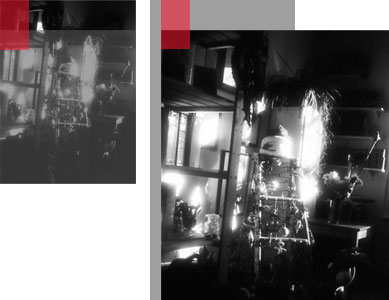


1996 AD
“Santa Claws”, Santa kills porn industry workers.
Santa begins to appear as the poster boy for negative economic events.
This underscores Santa Claus as a social, economic and political force.

1997 AD
“Jack Frost”
A serial killer dies, comes back as a snowman and wrecks havoc.

1998 AD
Mr & Mrs Claus need protection
2000 AD
“How The Grinch Stole Christmas” is released starring Jim Carry.
2001
“Santa Claus with Baby”
ONLY 35.00 / Hand Painted photographed in a second hand store window
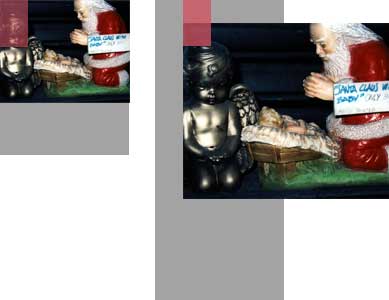
2002
“The Santa Clause 2” with Tim Allen is out.
2003
“Elf”, with Will Ferrell is released.

The “Teacher Story” appears.
2004 AD
2005 AD
Christmas Polluted by Consumerism
Pope Benedict XVI said that Christmas festivities have been polluted by consumerism…”In today’s consumer society, this time (of the year) is unfortunately subjected to a sort of commercial ‘pollution’ that is in danger of altering its true spirit, which is characterized by meditation, sobriety and by a joy that is not exterior but intimate. ”
2006 AD
And the richest fictional character is.. Tue Nov 21, 12:53 PM ET Move over Santa. The red-clad philanthropist has lost the top slot on Forbes magazines’ list of the 15 richest fictional characters to defense contractor Oliver “Daddy” Warbucks. Warbucks, a lieutenant general in the comic strip Little Orphan Annie, unseats Santa from the top position for the first time with an estimated net worth of $36.2 billion with the conflict in Iraq boosting his fortune. “We still estimate Claus’ net worth as infinite, but we excluded him from this year’s rankings after being bombarded by letters from outraged children insisting that Claus is ‘real’,” according to a statement from Forbes.com. Forbes.com said it took into account “the physical evidence – toys delivered, milk and cookies devoured” in removing him from consideration. How did Forbes calculate their worth? When possible on known commodity and share price movements or by comparing private businesses to comparable fictional public companies plus a “tiny grain of common sense and a large dose of salt.” Copyright © 2006 Reuters Limited. All rights reserved . ”
2007 AD

2007 AD
Santa Clauses are gathering on the tarmac of Sydney International Airport
AFP – Thursday, November 15 02:45 am
In this file photo, Santa Clauses are pictured gathering on the tarmac, after being “flown from The North Pole” to Sydney International Airport. Santas in Sydney have been told not to use Father Christmas’s traditional “ho ho ho” greeting because it may be offensive to women, it was reported Thursday.
